Dictionary of Horticultural Terms used on this Website
Short definitions and descriptions of many of the horticultural terms used on this website.
 Adaptable as a Houseplant - This means the plant can be grown indoors at least through the winter but likely all year.
Adaptable as a Houseplant - This means the plant can be grown indoors at least through the winter but likely all year.
Annual - A plant terminoloy pertaining to those that grow, flowers and may produce seed all in one season and then does not survive the winter. It must be planted each year. Many plants we call annual may be perennial in warmer locations.
Balled and Burlapped (B&B) - Generally larger trees or shrubs that were grown in the ground at a nursery. When ready for sale they are dug, wrapped in burlap and then sold. These days some plants may be placed in wire baskets in addition to being wrapped in burlap.
Bare Root - These are plants, usually trees and shrubs, that are sold with little to no soil around the roots. Some perennials are also sold as bare root plants, this is most common with mail ordered plants.
Biennial - a plant that produces foliage the first year, flowers the second year and then dies.
Bulb - Bulbs have a very specific definition, read it here, but most of us use bulb as a general term to refer to bulbs and bulb-like structures (corms, tubers and rhizomes.) These plants grow from an underground storage unit of some type. Bulbs can be both hardy and non-hardy.
CEC - Cation Exchange Capacity, is a measure of how much fertilizer your soil can hold and release over time. A high CEC is good because it means your soil will hold a lot of fertilizer. Clay soils have high CEC. A low CEC means you will have to fertilize more often. Sandy soils have low CEC.
Clay Soil - Soil composed of many tiny plate-like soil particles that can compact with time to form a hard, solid mass that makes shoveling difficult, digging holes more laborious, and often results in poor drainage.
Climbing - Plants that climb fences or other structures by using roots or stem structures to grip, vines are climbers.
Clump Forming - Plant that form clumps of foliage, often spreading to form other clumps close by.
Cool-Season Grass - These grasses put on most of their growth in spring before temperatures begin exceeding 75 degrees Fahrenheit and in the fall when temperatures cool down. They generally maintain good color through the summer but won't grow much when it is hot.
Compost - Compost is the decomposition of plants and other formerly living materials into a soil-like substance that is high in organic matter, an excellent fertilizer, and capable of improving almost any soil.
For more in depth composting information click here.
Container Plant Style - Plants used in combinations are sometimes classified as thrillers, fillers and spillers to identify what role each plant fulfills in a combination design. Container plant style identifies this designation.
Controlled Release Fertilizer - Also called Time Release Fertilizer. Fertilizer comes in pellets and is an improved version of Slow Release Fertilizer. Fertilizer is released based on soil temperature itself (not microbe action) and tends to be more exact than Slow Release Fertilizer.
Dappled Shade - Areas where there is a mixture of sun and shade, generally because a deciduous tree is nearby. Dappled shade is similar to partial shade.
Dead-head - to remove the old spent blooms and seed heads from a plant to help keep plants blooming longer.
For detailed information on deadheading click here.
Deciduous - Trees or shrubs that lose their leaves in fall and winter.
Deer Resistant Plants - Plants that deer are less likely to nibble on. Hungry deer (or rabbits, ground hogs, squirrels etc...) will, however, eat almost anything if they are hungry. Deer tastes also vary by region so trial and error may be necessary to choose deer resistant plants for your area.
Drought Avoidance - Plants that have developed storage capacity or other characteristics that enable them to weather severe drought without wilting, such as cacti, succulents etc...
Drought Resistant - Plants that can withstand periods with little to no supplemental water when planted and established in the landscape. No plant in a pot is truly drought resistant, they will all need some water. All plants will need to be watered while getting established. Annuals and perennials need 2 to 3 weeks to establish, shrubs and trees need a year to become established. Often used interchangeably with drought tolerant although their definitions are different.
Drought Tolerant - Plants that deal with severe drought on a regular basis, and recovers from repeated wilting. All plants will need to be watered while getting established. Annuals and perennials need 2 to 3 weeks to establish, shrubs and trees need a year to become established. Often used interchangeably with drought resistant although their definitions are different.
Dry - Water only when the soil is quite dry. Plants that prefer dry conditions may be susceptible to root rot disease if kept too wet. Dry plants will need little to no supplemental water once established if they are planted in the ground.
Dry to Normal - Water when the top of the soil in a pot is dry to the touch but err on the side of dry rather than wet. While these plants will be more tolerant of moist conditions than Dry plants they still do not like constantly moist soil. Dry to Normal plants will need little to no supplemental water once established if they are planted in the ground.
EC - a measure of how much salt is in your soil. High EC can mean that you have a problem from salt water or snow removal. Soils with very high EC can burn plants. A low EC means you need to fertilize (fertilzer is essentially make up of different types of salt). The salts that make up fertilizer are good for your plants (although too much can be bad). The salt from the ocean or snow removal is bad for plants.
End of the Hose Plant - A plant terminology that is generally tough, is considered low water usage, and generally needs little maintenance. End of the hose plants are great for the far corners of the garden where the hose doesn't reach.
Epiphyte
You are most likely to run into this term when growing houseplants since several popular varieties fit into this category. An epiphyte is a plant that attaches itself to another plant for support. They are unique from potted houseplants in that they do not send all of their roots down into the soil. Instead, their roots grow above ground and absorb nutrients from the air and rain. Some common types of epiphytes are air plants and Phalaenopsis orchids.
Exposure - the optimum amount of sun or shade each plant needs to thrive
Full Sun - More than 6 hours of direct sun a day
Partial Sun or Partial Shade - 4 to 6 hours of direct sun a day
Full Shade - less than 4 hours of direct sun a day
Dappled Shade - areas where there is a mixture of sun and shade, generally because a deciduous tree is nearby. Dappled shade is similar to partial shade.
For more in depth information on exposure click here.
Evergreen Grass - These grasses are usually plants that look like grasses but aren't actually classified as grasses. Plants like the sedges and carex are grass-like but not grasses.
Fertilizing - To add nutrition to your plants using either commercial or non commercial fertilizers or compost.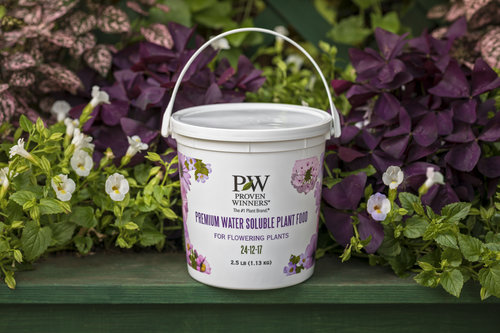
Controlled Release Fertilizer - Also called Time Release Fertilizer. Fertilizer comes in pellets and is an improved version of Slow Release Fertilizer. Fertilizer is released based on soil temperature itself (not microbe action) and tends to be more exact than Slow Release Fertilizer.
Heavy Feeders - Plants that need a lot of fertilizer for optimal performance. Regular applications of fertilizer are necessary for continued performance.
Light Feeders - Plants that do not need a lot of fertilizer for optimal performance. Over feeding Light Feeders can cause toxicity.
N-P-K - Ratio of Nitrogen to Phosphorous to Potassium in a fertilizer. These are the main nutrients required by plants.
Slow Release Fertilizer - Fertilizer that comes in pellets and is slowly released based largely on microbes which are more or less active based on soil temperatures.
Time Release Fertilizer - Also called Controlled Release Fertilizer. Fertilizer comes in pellets and is an improved version of Slow Release Fertilizer. Fertilizer is released based on soil temperature itself (not microbe action) and tends to be more exact than Slow Release Fertilizer.
Trace Elements - Nutrients that plants need in small amounts. Common trace elements include Boron, Copper, Iron, Manganese, Molybdenum, and Zinc. These elements are usually included in most commercial fertilizers.
Water Soluble Fertilizer - Fertilizer that either comes in liquid form or comes in crystal form that is dissolved in water.
For in depth information on fertilizing click here.
Filler - Plants that fill in the middle area of a container connecting the spillers and fillers and making the container look full.
Frost-Free Date - Average date in spring when your area no longer experiences frost and the average date in fall for when your area experiences the first frost. This date is important for knowing when to plant in spring. Knowing both spring and fall frost dates will help you determine the length of your growing season.
Full Shade - less than 4 hours of direct sun a day
Full Sun - 6 or more hours of direct sun a day
Genera - The plural form of genus, see below. It is used when referring to more than one plant genus. For instance, "the Petunia and Verbena genera have great garden applications."
Genus - The first part of the two-part scientific name that is used for plants on our website.
Habit - The general structure of the plant.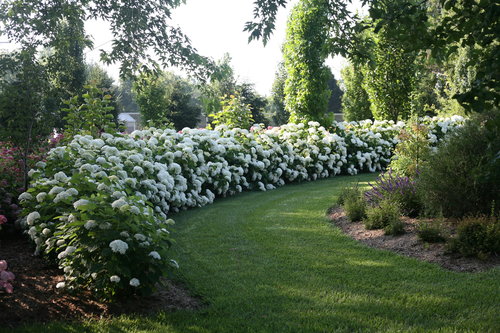
Climbing - Plants that climb fences or other structures by using roots or stem structures to grip, vines are climbers.
Clump Forming - Plant that forms clumps of foliage, often spreading to form other clumps close by.
Mounded - Plants with a rounded appearance, they are usually wider than they are tall.
Spreading - Plants that grow low and spread along the ground, rooting at nodes along the stem.
Trailing - Plants that trail along the ground or out of pots but do not root at nodes along the stem.
Upright - A plant that is taller than it is wide with straight (more or less) edges, these plants often have a somewhat spikey appearance.
"Hair Cut" - Using a sharp pair of scissors or shears to trim the ends of the branches off a plant, cutting an even amount off all parts of the plants, like your stylist giving you a haircut. If there are long pieces trailing or sticking out these would be trimmed back more so that at the end the plant is nicely even. A haircut will neaten the plant and encourage branching.
Harden Off - A process whereby a plant is gradually introduced to cold temperatures giving it a chance to build cold tolerance. Plants are naturally hardened off in the fall as temperatures grow colder. Hardening off is often used to acclimate greenhouse grown plants to cooler outdoor temperatures in spring. Hardening off will generally take several weeks.
Hardiness Zone - Temperature zones are based on the lowest average temperature each area is expected to receive during the winter. Hardiness zones are used to determine whether a plant is likely to be perennial in your area.
For in depth information on Hardiness Zones click here, to determine what zone you live in click here.
Headspace - Space left between the top of the soil and the top of the container. This space helps keep soil from washing out and help channel water into the container when watering. Without head space water can easily run off the top of the container.
Heat Tolerant - Plants that flourish despite hot temperatures.
Heavy Feeders - Plants that need a lot of fertilizer for optimal performance. Regular applications of fertilizer are necessary for continued performance.
Height, Medium - Plants that are between 10 and 24 inches in height. These plants are often used in the center (or between the tall and short plants) in a mixed bed or as filler in a container.
Height, Short - Plants that are 10 inches or less in height. These plants are often used in the front of mixed beds or the edges of pots.
Height, Tall - Plants that are 24 inches or more in height. These plants are often used at the back of mixed beds or in the center of containers.
Lawn Substitute - Plants that can take light foot traffic and may be used as substitutes for "normal" lawn grasses. While these plants cannot tolerate heavy foot traffic they will work in some areas.
Light Feeders - Plants that do not need a lot of fertilizer for optimal performance. Over feeding Light Feeders can cause toxicity.
Microclimate - Microclimate can be applied to a variety of things. For our purposes, it is a spot within a garden that differs from the general environment. Some examples would be a wet spot where water collects during rain, a spot that remains warmer in the winter - often due to a structure, a spot that is sheltered from the wind, a spot that is affected by ocean salt spray etc...
Mounded - Plants with a rounded appearance, they are usually wider than they are tall.
Mulch - It is a substance applied to the top of the soil around plants. It can be organic or inorganic and may serve several different purposes. Mulch is often made of bark or compost. Mulch helps retain soil moisture, decreases weeds, reduces erosion, helps cool plant roots, adds organic matter (provided organic mulch is used), increases the attractiveness of the landscape, and protects plants from adverse winter conditions.
For in depth information on Winter Mulch click here.
N-P-K - Ratio of Nitrogen to Phosphorous to Potassium in a fertilizer. These are the main nutrients required by plants.
Needs Good Drainage - These plants do not do well if they remain wet for extended periods of time and should be planted in locations or containers where water quickly drains.
Normal - Water when the top of the soil in a pot is dry to the touch. For in ground plantings they will need some supplemental water if there is an extended dry spell but will not need constant watering.
Normal to Wet - Water when the top of the soil in a pot is dry to the touch but err on the side of wet rather than dry. Plants that like Normal to Wet conditions will prefer that the soil be constantly moist and will not tolerate dry soils well. These plants are often good planted at pond edges. For in ground plantings you will need to provide an inch of water each week if mother nature doesn't do it for you.
Over-wintering - This plant terminology pertains to a process where a plant that is not cold hardy is taken indoors or otherwise manipulated to keep it alive through the winter
For in depth information on Over-wintering click here and here.
Partial Sun or Partial Shade - 4 to 6 hours of direct sun a day
Perennial - Plants that are cold hardy and will return again each spring. Some will flower the first year they are planted and some will need to mature before flowering. Some perennials are very long lived and others will survive only a few years.
Pet Friendly - Plants that are unlikely to be harmful to pets. Please check the ASPCA website for further information as Proven Winners does not make any recommendations or declarations about our plants and their "friendliness" to animals/pets.
pH - A measure of how acidic or basic your soil is. A pH of 7 is considered neutral. Acidic soils have a pH less than 7. Basic soils have a pH greater than 7. Most plants prefer a pH between 6 and 7. Some plants, called acid loving (azalea, camellia, citrus), will take a pH between 5 and 7. pH is Important because plants don't like soils that are too acidic or basic. pH can be adjusted using amendments.
Pinch - Removing a portion of the plant, often just the very tip of the shoots, to encourage branching. Often this is done by using your finger nails to pinch off the newest growth but scissors, pruning shears, or a knife can also be used.

Plant Disease terms
Immunity – A plant is immune when it cannot be infected by the disease or pathogen.
Resistance – A plant is susceptible to the disease, but has the ability to hinder or overcome the disease. Symptoms or damage may be present under heavy disease pressure.
High Resistance or Highly Resistant Plants – plants that are unlikely to be severely damaged by the disease or pathogen despite its presence in the environment.
Intermediate Resistance or Intermediately Resistant Plants – plants restrict damage from the pathogen or disease, but to a lesser extent than Highly Resistant plants.
Susceptible or Susceptibility – . This the opposite of resistance. The plant does not have the ability to resist or limit the damage from a pathogen, so the pathogen will cause serious consequences for the plant.
Tolerance – this is the term that is used when disease isn't the cause of stress of the plant. Things like heat stress, drought stress, pest infestations would fall under tolerance. Tolerance in this case means that the plant avoids serious harm in growth or performance despite being exposed to that particular stress.
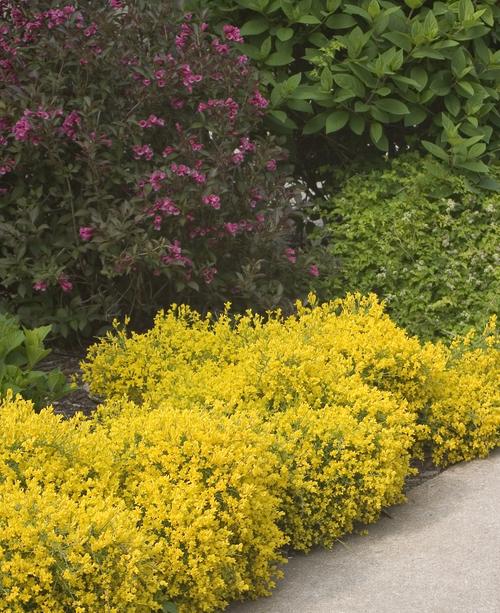 Prune - Using pruning shears, scissors, a knife, or loppers to shape or rejuvenate a plant, not to increase branching. Generally pruning is much more drastic than pinching. Pruning is most commonly used on shrubs, trees, and perennials.
Prune - Using pruning shears, scissors, a knife, or loppers to shape or rejuvenate a plant, not to increase branching. Generally pruning is much more drastic than pinching. Pruning is most commonly used on shrubs, trees, and perennials.
Right Place, Right Plant - A philosophy for planting a garden that relies on choosing the plants that are best suited to each specific location in your garden making it much easier to have a successful garden and will generally lower input of time and chemicals.
For in depth information on Right Place, Right Plant click here.
Root Bound - A plant that has been in a pot a long time may have roots that circle around the edges of the pot. These roots may not grow out into the soil. To encourage good root growth cut or break up the roots to separate them.
Root Rot - Fungal disease caused by several different types of fungi that causes the roots of a plant to turn brown, grey, and/or slimy. Root rot impairs a plants ability to uptake water and will often kill plants that are infected. Root rot is often caused by chronic overwatering. The most common symptom of root rot is a plant that is wilting even though the soil is wet.
For in-depth information on Root Rot click here.
Sandy Soil - Sandy soil is composed of many irregular to rounded tiny grains of sand, as opposed to the many tiny plate-like soil particles that make up a clay soil. Sandy soil drains very quickly and doesn't hold on to fertilizer well.
Saturation - This is when the entire root zone of a plant is moist after watering.
Scorch - When plants receive too much sun, pesticide or fertilizer the foliage may look brown or yellowish. The foliage in these cases is said to be scorched.
Self-cleaning - A term used when a plant sheds old blooms without human help. This is not the same as dead-heading which involves removing seed heads to prevent seed set.
Senesce - Deteriorating with age. Flowers senesce, for instance.
Senescence - when this term is used in horticulture, it refers to the process of aging in plants. Flowers aging and dying is one example of senescense.
Shrub - A woody plant that has multiple stems and branches at or near the ground. They are relatively small, especially when compared to trees.
Slow Release Fertilizer - Fertilizer that comes in pellets and is slowly released based largely on microbes which are more or less active based on soil temperatures.
Spiller - Plants placed along the edge of a combination container to spill or trail out of the pot.
Spreading - Plants that grow low and spread along the ground, rooting at nodes along the stem.
Sterile - A sterile flower or plant lacks the reproductive parts and ability to produce offspring. For flowers, theiroffspring would be seeds or fruit. For ferns, their offspring would come from reproductive structurescalled spores. The wordsterilityonly concerns reproduction. It does not have any bearing on a plant’sability to produce pollen or nectar. So, a flower that is sterile can still benefit pollinators. It just can’t befertilized, so it can’t produce any offspring.
Supplemental Water - Water added through irrigation using drip irrigation, soaker hoses, or other non-natural means.
Tender Perennial/Temperennial - Plants that are perennial in warm locations but are not winter hardy in cold locations. These plants are often treated as annuals in cold climates or may be in the house plant section.
Thriller - Plants that are placed in the center or back of a combination planter to add drama and height to the combination.
Time Release Fertilizer - Also called Controlled Release Fertilizer. Fertilizer comes in pellets and is an improved version of Slow Release Fertilizer. Fertilizer is released based on soil temperature itself (not microbe action) and tends to be more exact than Slow Release Fertilizer.
Toxicity - When a plant does not react well to something it is often called Toxicity. Toxicity could refer to too much fertilizer, too much sun, sensitivity to insecticides etc...
Taxonomist - A scientist whose job it is to classify plants, or other organisms, into their correct Scientific classifications. We use Genus and Species on this site. With new information available via DNA information there is currently a fair amount of reclassification happening.
Topsoil - the upper layer of soil that you plant in. It varies in depth from place to place, but will almost always be less than a foot deep and can be as little as 2 inches deep
Trace Elements - Nutrients that plants need in small amounts. Common trace elements include Boron, Copper, Iron, Manganese, Molybdenum, and Zinc. These elements are usually included in most commercial fertilizers.
Trailing - Plants that trail along the ground or out of pots but do not root at nodes along the stem.
Tree - A woody plant with a single stem and branches that begin some distance from the ground. They are relatively large, especially when compared to shrubs.
Upright - A plant that is taller than it is wide with straight (more or less) edges, these plants often have a somewhat spikey appearance.
Variegated Foliage - Foliage with different colors, usually but not always random, alternating on the foliage.
Warm-season Grass - These grasses won't start growing until mid to late spring or even early summer. Their major growth and flowering happens when the weather is hot. They will usually turn shades of brown for the winter.
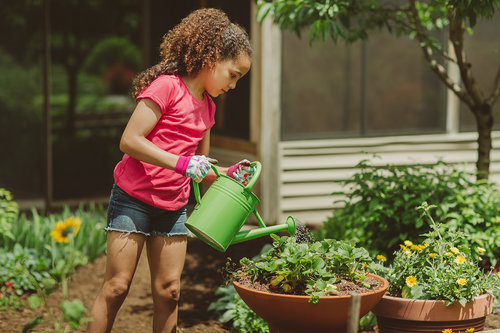 Watering - Plants differ somewhat on how much water they require and will generally fall into 5 categories. These categories are most relevant for plants in containers but also apply to in ground plantings.
Watering - Plants differ somewhat on how much water they require and will generally fall into 5 categories. These categories are most relevant for plants in containers but also apply to in ground plantings.
Dry - Water only when the soil is quite dry. Plants that prefer dry conditions may be susceptible to root rot disease if kept too wet. Dry plants will need little to no supplemental water once established if they are planted in the ground.
Dry to Normal - Water when the top of the soil in a pot is dry to the touch but err on the side of dry rather than wet. While these plants will be more tolerant of moist conditions than Dry plants they still do not like constantly moist soil. Dry to Normal plants will need little to no supplemental water once established if they are planted in the ground.
Normal - Water when the top of the soil in a pot is dry to the touch. For in ground plantings they will need some supplemental water if there is an extended dry spell but will not need constant watering.
Normal to Wet - Water when the top of the soil in a pot is dry to the touch but err on the side of wet rather than dry. Plants that like Normal to Wet conditions will prefer that the soil be constantly moist and will not tolerate dry soils well. These plants are often good planted at pond edges. For in ground plantings you will need to provide an inch of water each week if mother nature doesn't do it for you.
Wet - These plants need soil that is constantly moist to wet. Plants in the wet category also will do well on pond edges or as pond plantings. They do not tolerate dry soils.
For in depth information on watering container plants click here and for in depth information on watering landscape plants click here.
Water Plant - Plants that can grow on pond edges or in ponds or streams.
Water Soluble Fertilizer - Fertilizer that either comes in liquid form or comes in crystal form that is dissolved in water.
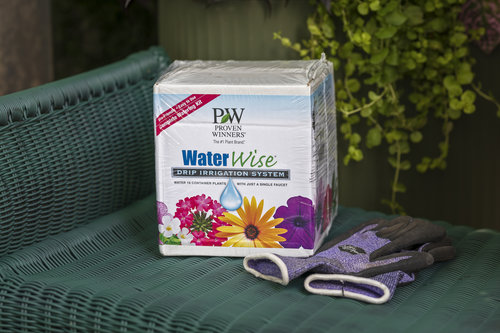 WaterWise - A plant that does well in a landscape that manages water sensibly, using moisture zones and managing water use. Includes other aspects such as mulching, reduction of turf grass etc...
WaterWise - A plant that does well in a landscape that manages water sensibly, using moisture zones and managing water use. Includes other aspects such as mulching, reduction of turf grass etc...
Wet - These plants need soil that is constantly moist to wet. Plants in the wet category also will do well on pond edges or as pond plantings. They do not tolerate dry soils.
Wet Feet - When the soil in a container or the landscape stays wet, plants may be referred to as having wet feet. The roots on some plants do not like to be constantly wet and we might say that the plant doesn't like to have wet feet. Conversely, the roots on some plants don't mind being constantly wet and we might say tthat the plant doesn't mind having wet feet.
Xeriscape - a landscape style that employs drought-resistant plants to help conserve water.




